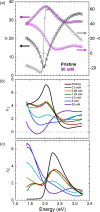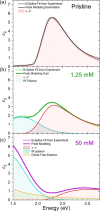Quantifying Charge Carrier Localization in PBTTT Using Thermoelectric and Spectroscopic Techniques
- PMID: 37415971
- PMCID: PMC10320779
- DOI: 10.1021/acs.jpcc.3c01152
Quantifying Charge Carrier Localization in PBTTT Using Thermoelectric and Spectroscopic Techniques
Abstract
Chemically doped poly[2,5-bis(3-alkylthiophen-2-yl)thieno[3,2-b]thiophene] (PBTTT) shows promise for many organic electronic applications, but rationalizing its charge transport properties is challenging because conjugated polymers are inhomogeneous, with convoluted optical and solid-state transport properties. Herein, we use the semilocalized transport (SLoT) model to quantify how the charge transport properties of PBTTT change as a function of iron(III) chloride (FeCl3) doping level. We use the SLoT model to calculate fundamental transport parameters, including the carrier density needed for metal-like electrical conductivities and the position of the Fermi energy level with respect to the transport edge. We then contextualize these parameters with other polymer-dopant systems and previous PBTTT reports. Additionally, we use grazing incidence wide-angle X-ray scattering and spectroscopic ellipsometry techniques to better characterize inhomogeneity in PBTTT. Our analyses indicate that PBTTT obtains high electrical conductivities due to its quickly rising reduced Fermi energy level, and this rise is afforded by its locally high carrier densities in highly ordered microdomains. Ultimately, this report sets a benchmark for comparing transport properties across polymer-dopant-processing systems.
© 2023 American Chemical Society.
Conflict of interest statement
The authors declare no competing financial interest.
Figures






Similar articles
-
Effect of Alkyl Side Chain Length on Doping Kinetics, Thermopower, and Charge Transport Properties in Highly Oriented F4TCNQ-Doped PBTTT Films.ACS Appl Mater Interfaces. 2019 Feb 6;11(5):4942-4953. doi: 10.1021/acsami.8b17594. Epub 2019 Jan 28. ACS Appl Mater Interfaces. 2019. PMID: 30644706
-
Closing the Stability-Performance Gap in Organic Thermoelectrics by Adjusting the Partial to Integer Charge Transfer Ratio.Macromolecules. 2020 Jan 28;53(2):609-620. doi: 10.1021/acs.macromol.9b02263. Epub 2020 Jan 8. Macromolecules. 2020. PMID: 32089566 Free PMC article.
-
Screening of Coulombic Interactions To Achieve a Higher Power Factor in Conjugated Polymers.ACS Appl Mater Interfaces. 2025 Feb 12;17(6):9431-9439. doi: 10.1021/acsami.4c20823. Epub 2025 Jan 29. ACS Appl Mater Interfaces. 2025. PMID: 39881497
-
Greatly increased electrical conductivity of PBTTT-C14 thin film via controllable single precursor vapor phase infiltration.Nanotechnology. 2022 Oct 20;34(1). doi: 10.1088/1361-6528/ac96fa. Nanotechnology. 2022. PMID: 36191569
-
Boosting Thermoelectric Performance of Semicrystalline Conducting Polymers by Simply Adding Nucleating Agent.Adv Mater. 2025 Mar;37(9):e2417594. doi: 10.1002/adma.202417594. Epub 2025 Jan 19. Adv Mater. 2025. PMID: 39828521
Cited by
-
Impact of Side-Chain Polarity and Symmetry on the Structure and Properties of Acyclic Dioxythiophene Polymers.Chem Mater. 2025 Jun 20;37(13):4593-4606. doi: 10.1021/acs.chemmater.4c03394. eCollection 2025 Jul 8. Chem Mater. 2025. PMID: 40656437 Free PMC article.
References
-
- Reynolds J. R.; Thompson B. C.; Skotheim T. A.. Handbook of Conducting Polymers; Marcel Dekker, 1998.
-
- Bubnova O.; Crispin X. Towards polymer-based organic thermoelectric generators. Energy Environ. Sci. 2012, 5, 9345–9362. 10.1039/c2ee22777k. - DOI
-
- Russ B.; Glaudell A.; Urban J. J.; Chabinyc M. L.; Segalman R. A. Organic thermoelectric materials for energy harvesting and temperature control. Nat. Rev. Mater. 2016, 1, 16050.10.1038/natrevmats.2016.50. - DOI
LinkOut - more resources
Full Text Sources
Miscellaneous
